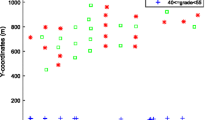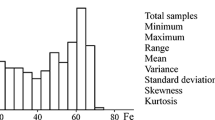Abstract
This paper re-examines the Itakpe iron ore deposit using geostatistics and artificial neural network techniques. Set of exploration information on the deposit are used to develop ordinary kriging (OK) model that produced a minimal error. The sensitivity analysis is used to choose a multilayer perceptron (MLP) network model as the optimum network for the ANN. The OK model showed a better performance for grade estimation when compared with the MLP model. Thus, using OK, a total resource of about 12% lower than that of the conventional method, which is currently in use in Itakpe, is obtained.















Similar content being viewed by others
References
Akeju VO, Afeni TB (2015) Investigation of the spatial variability in Oyo-Iwa limestone deposit for quality control. J Eng Sci Technol 10(8):1065–1085
Al-Alawi SM, Tawo EE (1999) A comparison between artificial neural network and a geostatistical technique in the estimation of regionalized variables. Eng J Univ Qatar 12:125–149
Asghari O, Hezarkhani A (2006) Geostatistical modeling and reserve estimation of Choghart iron ore deposit through ordinary kriging method. In Proceedings of the 5th International Scientific Conference – SGEM pp. 631-642
Asghari O, Fatemeh S, Hassan BA (2009) The comparison between sequential Gaussian simulation (SGS) of choghart ore deposit and geostatistical estimation through ordinary kriging. Aust J Basic Appl Sci 3(1):330–341
Badel M, Angorani S, Panah MS (2011) The application of median indicator kriging and neural network in modeling mixed population in an iron ore deposit. Comput Geosci 37(4):530–540
Beale MH, Hagan MT, Demuth HB (2012) Neural network toolbox user’s guide. The MathsWorks Inc., Natick
Blackwell GH, Sinclair AJ (2004) Applied mineral inventory estimation. Cambridge University Press, UK
Bluman AG (2004) Elementary statistics: a step by step approach, 5th ed. McGraw Hill Publications, New York
Chatterjee S, Bhattacherjee A, Samanta B, Pal SK (2006) Ore grade estimation of a limestone deposit in India using an artificial neural network. Applied GIS 2(1):3.1–03.20
Chilès JP, Delfiner P (2009) Geostatistics: modeling spatial uncertainty, John Wiley and Sons
Deutsch CV, Journel AG (1998) GSLIB Geostatistical Software Library and User’s Guide, 2nd Ed. Oxford University Press, New York
Deutsch CV, Leuangthong O, Ortiz MJ (2007) Case for geometric criteria in resources and reserves classification. Soc Min Metall Explor 322:1–11
Dominy SC, Noppe MA, Annels AE (2002) Errors and uncertainty in mineral resource and ore reserve estimation: the importance of getting it right. Explor Min Geol 11(1-4):77–98
Dutta S, Bandopadhyay S, Ganguli R, Misra D (2010) Machine learning algorithms and their application to ore reserve estimation of sparse and imprecise data. J Intell Learn Syst Appl 2:86–96
Goh AT, Kulhawy FH (2003) Neural network approach to model the limit state surface for reliability analysis. Can Geotech J 40(6):1235–1244
Goswami AD, Mishra MK, Patra D (2017) Investigation of general regression neural network architecture for grade estimation of an Indian iron ore deposit. Arab J Geosci. https://doi.org/10.1007/s12517-017-2868-5
Haldar SK (2013) Mineral exploration: principles and applications, 1st ed., Elsevier Inc.
Icer S, Kara S, Guven A (2006) Comparison of multilayer perceptron training algorithms for portal venous Doppler signals in the cirrhosis disease. Expert Syst Appl 31(2):406–413
Idris MA, Saiang D, Nordlund E (2015) Stochastic assessment of pillar stability at Laisvall mine using artificial neural network. Tunn Under Space Technol 49:309–319
Jafrasteh B, Fathianpour N (2017) A hybrid simultaneous perturbation artificial bee colony and back-propagation algorithm for training a local linear radial basis neural network on ore grade estimation. Neurocomp 235:217–227
Jafrasteh B, Fathianpour N, Suarez A (2018) Comparison of machine learning methods for copper ore grade estimation. Comput Geosci 22:1371–1388
Jalloh A, Sasaki K, Jalloh Y Barrie AK (2016) The integration artificial neural networks and geostatistical 3D geological block modeling: a case study on a mineral sand deposit. Proceedings of the 24th International Mining Congress of Turkey, IMCET pp. 257-263
Kapageridis I, Denby B (1998) Neural network modelling of ore grade spatial variability. Proceedings of the International Conference for Artificial Neural Networks pp. 209-214
Krige DG (1996) A practical analysis of the effects of spatial structure and of data available and accessed, on conditional biases in ordinary kriging. 5th International Geostatistics Congress, Wollongong, Australia pp. 799-810
Lane KF (1988) The Economic definition of ore: cut-off grades in theory and practice. Mining Journal Books, London
Lawal AI, Idris MA (2019) An artificial neural network-based mathematical model for the prediction of blast induced ground vibrations. Int J Environ Stud 77:318–334. https://doi.org/10.1080/00207233.2019.1662186
Marzeihe SK, Hassan M, Hossein H, Parvizz M (2013) Determining the best search neighbourhood in reserve estimation, using geostatistical method: a case study anomaly no. 12a iron deposit in central Iran. J Geol Soc India 81:581–585
Nezamolhosseini SA, Mojtahedzadeh SH, Gholamnejad J (2017) The application of artificial neural networks to ore reserve estimation at Choghart iron ore deposit. Anal Numer Methods Min Eng 6:73–83
Olade MA (1978) General features of Precambrian iron ore deposit and its environment at Itakpe ridge, Okene Nigeria. Trans Inst Min Metal Sec B 87:81–89
Sahin MA, Jaksa MB, Maier HR (2001) Artificial neural network applications in geotechnical engineering. Aust Geomech 36(1):49–62
Samanta B, Bandopadhyay S (2009) Construction of a radial basis function network using an evolutionary algorithm for grade estimation in a placer gold deposit. Comput Geosci 35(8):1592–1602
Sarani F, Ahangar GA, Shabani A (2015) Predicting ESP and SAR by artificial neural network and regression models using soil pH and EC data (Miankangi Region, Sistan and Baluchestan Province, Iran). Arch Agron Soil Sci 62(1):150414060638008
Sarkar BC (2014) Geostatistics: concepts and applications in mineral deposit modeling for exploration and mining. J Indian Geol Congr 6(1):3–26
Sarkar BC, Gandhi SM (2016) Essential of mineral exploration and evaluation. Elsevier Inc.
Sarkar BC, Roy I (2005) A geostatistical approach to resource evaluation of kala iron ore deposit, Sundergarh dist., Orissa. J Geol Soc India 65(5):553–561
Tadeusiewicz R (2015) Neural networks in mining sciences–general overview and some representative examples. Arch Min Sci 60(4):971–984
Tahmasebi P, Hezarkhani A (2012) A hybrid neural networks-fuzzy logic-genetic algorithm for grade estimation. Comput Geosci 42:18–27
Taylor HK (1994) Ore reserves, mining and profit. Can Inst Min Metall Bull 87(983):38-46
Vann J (2007) Applied geostatistics for geologist and engineers. Quantitative Group Publishers, Western Australia.
Vann J, Jackson S, Bertoli O (2003) Quantitative kriging neighbourhood analysis for the mining geologist – a description of the method with worked case examples. 5th International Mining Geology Conference, Bendigo pp. 215-223
Wackernagel H (1995) Multivariate geostatistics-an introduction with applications. Springer, Berlin
Webster R, Oliver MA (2007) Geostatistics for environmental scientists. 2nd ed. John Wiley and Sons, Ltd., England
Wellmer FW (1998) Statistical evaluations in exploration for mineral deposits. Springer-Verlag, Berlin Heidelberg Tokyo New York 379 pp
Weston J, Ratle F, Collobert R (2008) Deep learning via semi-supervised embedding. In proceedings of the 25th international conference on Machine learning, Helsinki, Finland pp. 1168-1175
William WG (2010) Application of neural networks for instant iron-ore grade estimation. Expert Syst Appl 37(12):8729–8735
Wu X, Zhou Y (1993) Reserve estimation using neural network techniques. Comput Geosci 19(4):567–575
Yama BR, Lineberry GT (1999) Artificial neural network application for a predictive task in mining. Min Eng 51(2):59–64
Yunsel TY (2012) A practical application of geostatistical methods to quality and mineral reserve modelling of cement raw materials. J South Afr Inst Min Metall 112:239–249
Author information
Authors and Affiliations
Corresponding author
Additional information
Responsible Editor: Biswajeet Pradhan
Rights and permissions
About this article
Cite this article
Afeni, T.B., Lawal, A.I. & Adeyemi, R.A. Re-examination of Itakpe iron ore deposit for reserve estimation using geostatistics and artificial neural network techniques. Arab J Geosci 13, 657 (2020). https://doi.org/10.1007/s12517-020-05644-9
Received:
Accepted:
Published:
DOI: https://doi.org/10.1007/s12517-020-05644-9




